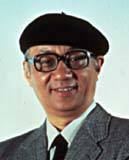![]()
![]()

Tezuka, Dr. Osamu
Born: November 3, 1928 Toyonaka, Osaka, Japan
Died: February 9, 1989
Heralded by many as the "God of Manga," Tezuka Osamu was one of Japan's most cherished and prolific manga and anime artists. He has been described as the "Japanese Walt Disney," despite his reported disdain for the company. He, perhaps more than any other artist, was responsible for the very characteristic "puppy-dog eyes" which has become a trademark of Japanese animation, though he later admitted being heavily influenced by the works of Walt Disney -- in particular, Bambi. Dr. Tezuka did receive his medical degree from Osaka University in 1946, though he concentrated on his career of choice: the art of manga and animation. His most famous creation is probably 'Tetsuwan Atom', which has a large following internationally as 'AstroBoy'. NBC later aired three of his TV series: AstroBoy, Kimba the White Lion (which many have claimed as Disney's inspiration for The Lion King), and Princess Knight.
His first production company, formed in 1961, 'Mushi Productions', was later replaced by his namesake corporation, 'Tezuka Productions' in 1968. Dr. Tezuka was heavily involved with experimental animation, and had won several international animation awards, including the Grand Prix for Jumping at the 1984 Zagreb International Festival, the Grand Prix for Broken Down Film at the Hiroshima International Animation Festival, and the CIFEJ award for Legend of the Forest at the 1988 Zagreb International Film Festival.
A cursory list of his works include:
- Ma-chan's Diary
- New Treasure Island
- Lost World
- Next World
- Jungle Taitei (Jungle Emperor / Kimba the White Lion), 1950
- Tetsuwan Atom (The Mighty Atom / AstroBoy), 1952-1968
- Princess Knight, 1953
- Story of a Street Corner, 1962
- Memory, 1964
- Mermaid, 1964
- Ambassador Magma, 1965
- Drop, 1965
- W3 (Amazing 3), 1965
- Pictures at an Exhibition, 1966
- Dororo, 1967
- The Phoenix, 1967
- The Genesis, 1968
- One Thousand and One Nights, 1969
- Cleopatra,1970
- Ode to Kirihito, 1970
- A History of Birdmen, 1971
- A Hundred Tales, 1971
- Ayako, 1972
- Black Jack, 1973
- Buddha, 1973
- MW, 1976
- Phoenix 2772 (Space Firebird), 1980
- A Tree in the Sun, 1981
- Tell Adolph, 1983
- Jumping, 1984
- Broken Down Film, 1985
- Legend of the Forest, 1987
- Ludwig B., 1987
- Murasama, 1987
- Push, 1987
- Neo Faust, 1988
- Self-portrait, 1988
The National Museum of Modern Art in Tokyo held a public exhibit of Dr. Tezuka's works in 1990 -- the first ever for a "commercial manga artist." April 24, 1994 became a hallmark in manga and anime history: The Osamu Tezuka Manga Museum was opened in his hometown of Takarazuka, in memory of the prolific artist.
![]()
[ << prev ] [ top ] [ next >> ]
[ home ]
[ what's new ]
[ café contest ]
[ café reviews ]
[ parent's guide ]
[ encyclopædia ]
[ café trivia ]
[ café latté ]
[ café espresso ]
[ about the café ]
[ feedback ]
[ links ]
[ site map ]
© 1997-2000. All rights reserved. The Animé Café logo and the Crystal Kyoko award are original creations of the Animé Café. Please do not use any of the materials on this site without the expressed written permission of the Animé Café.
Page last modified 2000.03.14
